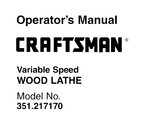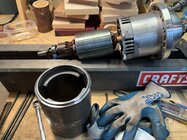 Craftsman 2hp variable speed lathe. Has worked fine for months, but suddenly stalls and won’t turn. Formerly I could turn the spindle by hand- now it seems bound up and I can just turn it with the chuck wrench. Tore it completely apart. Rear bearing spins free and easy. When the rotor is removed from the magnetic housing, it spins free and clear, easily. But when placed back in the housing and carefully aligned and tightened, still binding up. I’m mystified. Help?
Craftsman 2hp variable speed lathe. Has worked fine for months, but suddenly stalls and won’t turn. Formerly I could turn the spindle by hand- now it seems bound up and I can just turn it with the chuck wrench. Tore it completely apart. Rear bearing spins free and easy. When the rotor is removed from the magnetic housing, it spins free and clear, easily. But when placed back in the housing and carefully aligned and tightened, still binding up. I’m mystified. Help?(And thanks, I’m not seeking opinions about whether this is a good lathe. Just helpful comments, please. TIA)

